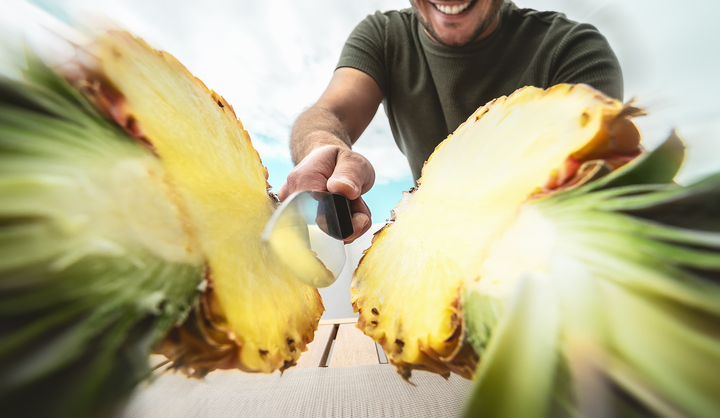Tepache is a traditional Mexican fermented drink with a rich history, crafted from pineapple rinds, piloncillo (unrefined cane sugar), and warming spices like cloves and cinnamon.
Tangy, refreshing, and mildly alcoholic (usually less than 2%), this beloved beverage has been enjoyed for centuries in Mexico — both for its health benefits and its role in cultural rituals.
Read on for more on tepache’s health benefits, its cultural significance in Mexico, and how to easily make it at home.
Health Benefits of Tepache
Tepache has numerous health and wellness benefits. It’s full of probiotics and lots of vitamins and nutrients.
It’s not just good for us. It also reduces food waste because it uses leftover pineapple skins that would otherwise go in the trash.
While the exact nutritional content of tepache can vary depending on the ingredients and fermentation process, it generally contains vitamins (B and C), minerals (calcium, magnesium, potassium), and probiotics.
Pineapple, the main fruit used to make tepache, contains bromelain, a natural enzyme that’s known for its anti-inflammatory properties.
Research by Mount Sinai shows that bromelain is potentially helpful in treating conditions like arthritis and recovery from injuries and surgeries because it reduces inflammation, muscle soreness, and decreases swelling.
Some studies also suggest bromelain improves respiratory conditions such as asthma and allergies by modulating immune responses.
Pineapple is a powerful wellness booster.
This is due to its high vitamin C and antioxidant content, which strengthens the immune system and contributes to overall health.
Vitamin C acts as a robust antioxidant that protects cells from free radical damage, essential for maintaining a healthy immune response.
This antioxidant effect helps to fend off illnesses, supports tissue repair, and reduces the impact of oxidative stress, which is linked to chronic diseases and aging.
Pineapple’s B vitamins, include B1 (thiamine) and B6, and are essential for supporting energy production and brain health.
Vitamin B1, or thiamine, plays a central role in converting carbohydrates into energy.
This helps maintain this fuel balance, promoting mental clarity and nerve health.
Vitamin B6, on the other hand, is involved in brain development and cognitive function. It helps to regulate mood and mental health. And it aids in producing red blood cells, which carry oxygen throughout the body, fueling overall metabolism and energy stability.
Calcium, potassium, and magnesium are minerals found in tepache, all of which are crucial for bone health, nerve function, and maintaining electrolyte balance.
Some tepache recipes add cinnamon, rich in antioxidants. It can also reduce inflammation and improve blood sugar regulation.
All these elements work together for a holistic effect supporting immunity and overall body resilience.
Natural Drink for Gut Health
Bromelain is not only anti-inflammatory, but it may also help treat digestive disorders by aiding protein digestion and improving nutrient absorption.
The benefit of natural fermentation is the production of probiotics, which promote gut health by improving nutrient absorption, digestion, and balancing the gut microbiome.
Tepache’s Role in Mexican Culture
Tepache has roots in Mexico, particularly among the Nahua and Mayan cultures.
The Mayans considered it a sacred drink, used in rituals and ceremonies. They also added different herbs, depending on what the drink would be used for.
The word “tepache” comes from a combination of the Nahuatl words “tepachoa,” meaning “to grind” or “to make pulp” and “tepiātl,” meaning “drink made from corn.”
It was originally made by the Nahua people using maize rather than the pineapple-based version we know today.
The recipe evolved as pineapples became more accessible, replacing corn as the base and adding a sweeter twist to this ancient beverage.
It’s enjoyed across regions with minor variations in recipe and flavor.
For example, Jalisco’s tepache is often sweeter and more rustic due to different fermentation techniques.
Traditionally, it’s enjoyed as a mildly alcoholic beverage at family gatherings or in local markets, served out of a clay mug or in a clear plastic bag with a straw in it.
As interest in fermented beverages and probiotic drinks has grown, tepache production has expanded beyond Mexico and is increasingly popular worldwide.
[Related Read: The Health Benefits of Pulque: Mexico’s Ancient Elixir]
How to Make Tepache at Home
One of the best parts about tepache is how easy it is to make at home with just a few ingredients.
The preparation involves fermenting the pineapple with sugar and spices in water, allowing the natural yeasts to promote fermentation.
It usually takes about 2 – 3 days at room temperature (around 20 – 25°C or 68 – 77°F) to achieve the desired flavor.
Some people add other fruits and/or spices, enhancing its complexity. This simple yet versatile beverage can be tailored to individual preferences, making each batch unique.
All you need are pineapple peels, piloncillo, water, and cinnamon.
Here’s a recipe from The Spruce Eats that serves 4.
Prep time: 15 minutes
Fermentation time: 2-3 days
Ingredients:
- 4 1/2 cups water
- 1/2 cup piloncillo, or brown sugar
- 1 ripe fresh pineapple
- 1 cinnamon stick
Instructions:
- Combine ingredients: Add 4 1/2 cups water and 1/2 cup piloncillo or brown sugar in a pot or 2-quart mason jar. Stir to dissolve the sugar. If you are using piloncillo, it will take longer to dissolve. Stir the water occasionally with a wooden spoon and break the piloncillo up as it softens. Add (washed) Pineapple rind. You can also use the core if you want. Finally, add a cinnamon stick.
- Ferment: Cover the container and let it sit at room temperature for 2-3 days.
- Strain: Strain the tepache through a fine-mesh sieve to remove the solids.
- Serve chilled, over ice with a splash of lime or even Mezcal if you’re feeling adventurous!
Tips:
- Once it’s fermented, store tepache in the refrigerator. It will keep for up to a week.
- Add more piloncillo if you prefer a sweeter taste.
- If you want it spicier, add cloves or a pinch of chili powder.
- You can also add other fruits or spices to your tepache for a different flavor. Mango, guava, cantaloupe or oranges, lemons, or limes to add a citrusy twist.


